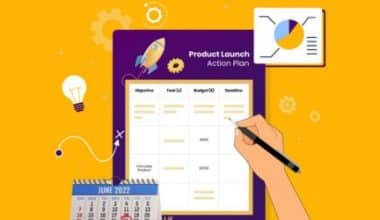CRM systems are necessary for effective business-customer relationships and communications. With the right system strategy, customer relationship management systems can help you boost sales by keeping track of customers from the lead nurturing process to completing the purchase and maintaining client loyalty. Automating your sales crew can also save you a lot of time and money. We’ll see some examples of these customer relationship management systems in this guide, with a general overview of how they work.
Customer Relationship Management Systems Defined
Customer relationship management (CRM) systems allow business owners to easily track all communications and nurture relationships with leads and clients. A CRM replaces the numerous spreadsheets, databases, and apps that many businesses use to keep track of customer data. As a result, there is an improved organization, efficiency, time management, and client satisfaction.
CRMs, or client management platforms, centralize all of your sales leads and client data. A CRM keeps track of all communications (form fills, phone calls, emails, text messages, and meetings), documents, quotations, transactions, and activities associated with each lead and client. Your entire team has instant access to those facts, allowing you to complete a transaction or give great service.
What Is the Purpose Of Customer Management Systems?
Any customer information system, including CRM software, must include contact management. The goal of a CRM is to store and manage all data for all types of contacts, ranging from leads to business partners.
Customer Management System Process
In today’s fast-paced business world, every company requires its own customer management strategy in order to maintain market share, enhance products and services, and stay ahead of the competition.
The time, resources, and effort invested by a firm in building a thorough customer management system process pays off directly, most commonly with higher retention – and increased profitability.
What Is the Customer Management System Process?
A customer management system process describes how an organization’s customer-facing activities are carried out. A customer’s rate of growth is directly linked to the company’s rate of growth! As a result, the company’s performance reflects the level of satisfaction of its customers. The higher the risk of churn, the more disgruntled customers a company has. Similarly, the more satisfied customers a firm has, the more loyal customers, brand advocates, and retained customers it will generate.
In a customer management process, the emphasis is on the Customer Success Manager role’s Strategy, Process, People, and Technology, as well as the relationships between these elements in current practice.
Elements Of The Customer Management System Process
#1. Customer Contentment
The notion of putting the client first must be ingrained in organizational culture. In order to uncover sales possibilities and generate personalized, high-quality items that consumers would find valuable, the company must connect itself with the needs of its customers.
#2. Customer Involvement
It is critical to engage with clients throughout their journey. One crucial strategy to keep the interest of a customer is to continually give outstanding service, which can permanently cement a link between CSM and the client.
#3. Relationship development
Relationship development is a long-term investment with guaranteed results if done correctly. When executed correctly, RMS fosters brand trust, causing customers to return for more and become brand ambassadors through good word-of-mouth endorsements.
Customer Relationship Management Strategy
A customer relationship management (CRM) strategy is a data-driven method that allows you to interact with your clients on a more personal level by providing customized content. This method can enable staff to collaborate to give excellent customer service.
What is a Customer Relationship Management Strategy?
A customer relationship management (CRM) strategy is a company plan that aims to increase revenue while improving customer service. Its purpose is to convert prospective leads into consumers and keep existing customers by providing interesting material tailored to their specific interests. CRM strategies achieve this purpose by combining processes, behaviors, and technology. The modern strategy has transitioned away from transactional sales and toward a more customer-centric paradigm. It recognizes how professionals may use data to handle client diversity.
Why is a Customer Relationship Management strategy necessary?
An effective CRM strategy is vital since it minimizes the cost of client acquisition and raises the customer’s lifetime value. This is a valuable outcome because it allows business leaders to devote their time and energy to growing the company rather than simply maintaining sales. The following are the primary advantages of implementing a CRM strategy:
#1. Improves customer communication
CRM strategies combine multiple data points about your customers. It reveals information about their tastes, values, and personal aspirations in addition to geographical data. These minor details assist you in developing a more accurate consumer profile. You can use it to further segment your audience and customize your content. Customers will appreciate the care you take in your messages. In the long run, it generates strong relationships and brand loyalty.
#2. Encourages data-driven decision-making
A CRM strategy improves the dependability of your marketing tactics by providing more data points to draw from. It helps you to divide the overall organizational aim into smaller, more specific goals. By segmenting your audience based on their commonalities, you may better tailor your approach to diverse markets. In this manner, you can make the most use of your resources to achieve the best results.
#3. A successful sales cycle
When you utilize more precise approaches to target niches in your consumer base and back up your marketing activities with accurate data, you lessen the likelihood of wasting resources. A CRM approach improves the marketing and sales connection. You not only increase sales by establishing loyal consumers, but you also increase profits by lowering overhead expenditures. Because a CRM approach saves you time during the research and development stage, you make more money by focusing your resources on future growth.
How can you create an effective CRM strategy?
A clear vision on which your team can collaborate and execute is required to establish a successful CRM strategy. It demands your capacity to discriminate between good and poor leads so that you can prioritize your efforts. Implementing a CRM strategy is a continuous process. You must continue to track your leads, run customized marketing efforts, and analyze your actions.
The following is an eight-step process for developing a strong CRM strategy:
- Specify your objectives.
- Create a profile of your ideal consumer.
- Outline your consumer journey.
- Tell us about your customer service experience.
- Carve out a niche in the current market for yourself.
- Be familiar with your product or service.
- Purchase CRM software.
- Establish KPIs for your team.
Examples Of Customer Relationship Management Systems
Here are some examples of customer relationship management systems that are now accessible:
#1. HubSpot
HubSpot is a CRM platform, which means it keeps track of client interactions while also facilitating marketing, sales, and service operations. It is suitable for every growing business (small, medium, or large) and any team (such as marketing, sales, customer service, operations, or C-suite).
The platform combines Marketing Hub, Sales Hub, Service Hub, and CMS — as well as hundreds of available integrations — to assist you in aligning all internal teams, gathering meaningful insights, reporting on (and sharing) success and growth opportunities, creating remarkable customer experiences, increasing adoption, and delighting your target audience throughout every stage of the buyer’s journey.
#2. Microsoft Dynamics
Microsoft Dynamics is a CRM and enterprise resource planning (ERP) software that is designed to increase sales and marketing productivity. The CRM collects social insights, manages campaigns in the cloud, and provides business intelligence.
You can have your CRM provided via the cloud, hosted, or on-premises. Microsoft Dynamics provides apps that allow you to manage your customer interactions from your mobile device, as well as link and sync data from social media with your CRM.
#3. EngageBay
EngageBay assists small businesses in properly managing client connections and sales processes. It has many features, including contact management, sales automation, lead capture, and marketing automation.
Companies also utilize EngageBay to manage their sales and marketing operations. Users can use the software to generate and track leads, as well as follow up on sales prospects. EngageBay also assists businesses in measuring their marketing initiatives to see what is and isn’t performing so that they can alter their strategy accordingly.
#4. Salesflare
Salesflare is a B2B sales CRM platform since it is designed to track and organize your B2B activities. It is designed from the ground up to automatically track everything. Their CRM generates contacts and enhances them with extra information such as email signatures, comprehensive customer timelines, and reminders to follow up.
The Salesflare CRM has an email sequence tool that allows you to send personalized emails at scale, making your outreach much more efficient. If you’re a frequent LinkedIn user, you’ll like their LinkedIn sidebar, which allows you to establish contacts from LinkedIn and get their email address with only a few clicks.
#5. Salesforce
Customer360, Salesforce’s CRM, combines customer data with sales, service, marketing, commerce, IT, and analytics in a single spot for easy access, shareable insights, and easy collaboration. Lead and contact management, sales opportunity management, workflow rules, automation, and customizable reports and dashboards are all features of the CRM. It is also available as a mobile app.
Salesforce provides a range of tools, such as Einstein AI, to help you reach your specific goals. The program also includes Employee Experience elements to improve job collaboration and motivation.
#6. Zoho
Zoho is a cloud-based CRM with integrated capabilities such as lead management and scoring, workflow automation, analytics, and marketing and process management. Zia, Zoho’s AI sales assistant, analyzes CRM data, tracks website traffic, and forecasts sales. These sales forecasts also highlight the leads that are most likely to convert and the deals that are most likely to close.
The gamification function in Zoho keeps your salespeople motivated and focused on quota, while the Google Ads integration connects your sales and marketing teams by displaying your company’s ad expenditure and sales revenue. Finally, Zoho may be used to deliver omnichannel support to clients and leads via phone, email, live chat, social media, or in-person.
#7. BIGContacts
BIGContacts’ user-friendly design and intuitive UI make client relationship management easier. Businesses may rely on the CRM tool to keep track of all customer data and interactions. It offers a 360-degree view of contact information, including previous interactions, social network accounts, notes, files, and scheduled activities. The technology improves team cooperation, gives meaningful business information, and aids in the growth of organizations.
BIGContacts provides features such as sales funnel management, web form integration, lead nurturing, and task tracking. Custom reports and dashboards are also available to help you acquire a better understanding of your company’s activities. With detailed calendar views, automated repeating tasks, and configurable reminders, BIGContacts may also be a great task management tool.
#8. Pipedrive
Pipedrive is a small-team-friendly sales CRM and pipeline management application. The software includes tools for tracking performance, managing deals, forecasting revenue, and automating repetitive processes. Pipedrive automatically visualizes your pipeline, allowing you to pinpoint where your efforts should be directed.
Pipedrive features sales forecasting and connections, allowing you to connect your existing tools, such as Mailchimp or Zapier, to your CRM. There is also a security feature that explains how your company’s data is used.
#9. Freshworks
Freshworks is a sales CRM and customer interaction software that employs artificial intelligence to assist your sales and marketing teams in providing tailored customer experiences. It is divided into two parts: the Sales Cloud and the Marketing Cloud.
The Sales Cloud helps with lead generation, lead qualification, and deal closing. It also employs AI to anticipate sales and predict which actions sales representatives should take with prospects.
Marketing Cloud allows you to conduct automated discussions with customers via an AI-powered chatbot. It also reveals information about audience behavior and interaction, allowing you to focus your efforts and develop highly targeted campaigns and experiences.
#10. ActiveCampaign
ActiveCampaign is a customer experience automation platform and CRM that allows you to automate a variety of chores and job duties like email, segmentation, and personalization (across social media, email, live chat, SMS, and more). There are over 300 connectors available, including Shopify, Facebook, and WordPress, to let you adapt the CRM to your exact needs.
ActiveCampaign makes it simple to exchange customer lifecycle data across teams and use it to make smart decisions regarding customer interactions (e.g. what content you should send to them when to reach out, and what channel to reach out over). ActiveCampaign also assists you in better understanding and segmenting your clients on an individual basis by tracking buyer preferences, interaction, behavior, and unique traits.
What Are The Three Key Types Of CRM Systems?
CRM systems are classified into three types: operational, analytical, and collaborative.
Why Do Companies Use CRM Systems?
CRM enables companies to become more productive by coordinating and automating certain business processes.
What Are CRM Tools?
CRM tools allow you to maintain contact information for customers and prospects, identify sales possibilities, record service concerns, manage marketing campaigns all in one place and make information about every customer encounter available to everyone in your company who needs it.
How do I measure the success of my CRM system?
To measure the success of your CRM system, you may track metrics such as:
- Increase in customer retention and loyalty
- Increase in sales and revenue
- Reduction in customer complaints and support requests
- Increase in lead conversion and sales closing rates
- Increase in customer lifetime value.
How can I ensure the success of my CRM implementation?
To ensure the success of your CRM implementation, you may consider:
- Creating a clear CRM strategy and goals
- Involving all relevant departments and team members in the implementation process
- Providing adequate training and support for team members
- Continuously monitoring and evaluating the system’s performance and making adjustments as needed
- Encouraging team members to use the system regularly and provide feedback.
How do I choose the right CRM system for my business?
Choosing the right CRM system for your business may involve considering factors such as:
- The size and needs of your business
- The type of industry you are in
- The specific features and functionalities you require
- The ease of use and integration with other systems
- The cost and scalability of the system.
How can a CRM system improve customer service?
A CRM system can improve customer service by providing a centralized view of customer interactions and history, automating and streamlining customer service processes, providing real-time access to customer information and history, allowing for easy collaboration between customer service team members, and enabling customers to access their account and information through self-service portals.
How can a CRM system improve sales and marketing efforts?
A CRM system can improve sales and marketing efforts by providing insights into customer behavior and preferences, automating and streamlining lead management and sales processes, and providing real-time access to customer information and history for sales team members.
In Conclusion,
Customer relationship management systems boost the number of leads coming in by effectively storing and maintaining your customers’ information, allowing your marketing team to identify new customers faster. It assists your sales teams in closing deals more quickly. It also promotes customer service.
Frequently Asked Questions
What is a good CRM strategy?
A good CRM approach will help you provide an enjoyable customer experience; Improve coordination across sales, marketing, and customer service departments; identify the most valuable leads and opportunities clearly and swiftly.
Why is a CRM system beneficial?
A CRM platform’s data organization and presentation lead to a better understanding of clients.
How does CRM improve efficiency?
CRM allows you to manage your leads more successfully by prioritizing them in order of validity. A strong lead will be at the top of the list, where it can be followed up on straight away, but a poor lead will be further down the list.
Related Articles
- CLIENT MANAGEMENT SOFTWARE: Top 11 Picks For Your Business
- How To Start a Real Estate Business: Step-by-step Beginners Guide
- What is Customer Relationship Management Tools: Definition, Process and Examples
- Best 10 Customer Relationship Management (CRM) Software For Businesses
- Best Account Management Software For Your Business: Top 10 Reviews
- CRM Analytics: A Detailed Guide






